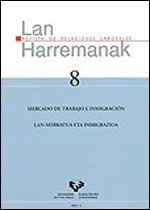Migraciones y cambio demográfico: la inviabilidad de los enfoques parciales de las políticas migratorias
##plugins.themes.bootstrap3.article.main##
##plugins.themes.bootstrap3.article.sidebar##
Abstract
In this article we will reflect on the present tendency to make migrations fit into certain parametres. These meet the aims of those who pose them, and the reality of migrations is therefore set apart; this is why the policies used bring no good results for fulfilling those aims and have a negative influence on the interests of the people involved. Moreover, this reflection will also help us realize about the fact that it is necessary to make an even harder effort to understand the new forms of international migrations. Nowadays, there seem to be enough signs to say that these present changes will bring a new era, utterly different from those we have just gone through. Globalization gives some good reasons in favour of this theory. This article is divided into two parts. The first one will offer the main referencies according to which migrations should be considered; and the second one will explain the present population tendencies, as well the debate on the extent to which migrations can help balance those tendencies.
How to Cite
##plugins.themes.bootstrap3.article.details##
Authors who publish in the journal "Lan Harremanak" do so in agreement with the following terms:
1. Authors retain the copyright of their papers. while ceding to the journal "Lan Harremanak" the right to the first publication of their article.
2. The publisher UPV/EHU Press is a joint copyright holder, in order to protect the legitimate use of the published paper and compliance with CC terms.
3. Published papers are subject to a Creative Commons CC-BY license (unless stated otherwise) which permits third parties to share the paper, on the condition that the author and source are specified when material is reproduced.
4. Authors can enter into other non-exclusive license agreements regarding the published version of their work (e.g. depositing it in an institutional repository or re-publishing it as a monographic volume), providing the author and source are given appropriate credit.
5. Dissemination of submitted articles via Internet is both allowed and recommended (e.g. in institutional repositories and/or on the researcher's web page), both before and during the process of submission, since this can lead to interesting dialogues and also increase citations to the eventual publication.

